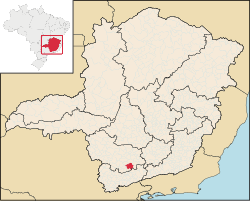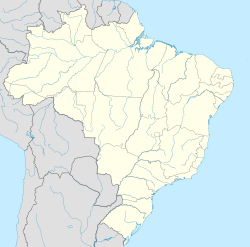Três Corações
Três Corações | |
|---|---|
City | |
 Três Corações Skyline | |
 Flag  Seal | |
 | |
 Três Corações Location in Brazil | |
| Coordinates: 21°41′41″S 45°15′19″W / 21.69472°S 45.25528°WCoordinates: 21°41′41″S 45°15′19″W / 21.69472°S 45.25528°W | |
| Country | |
| Region | Southeast |
| State | Minas Gerais |
| Mesoregion | |
| Microregion | |
| Settled | 1760s |
| Founded | June 14th, 1832 |
| Incorporated | September 23rd, 1884 |
| Government | |
| • Mayor | Claudio Cosme Pereira de Souza |
| Area | |
| • Total | 319.707 sq mi (828.038 km2) |
| Elevation | 2,753 ft (839 m) |
| Population (2020 [2]) | |
| • Total | 80,032 |
| Time zone | UTC-3 (BRT) |
| • Summer (DST) | UTC-2 (BRST) |
| Postal code | 37410-000 |
| Area code | 35 |
| HDI (2013) [1] | 0.744 |
| Website | trescoracoes.mg.gov.br |
Três Corações (Portuguese: [ˈtɾe(j)s koɾaˈsõjs], Three Hearts) is a municipality in the south of Minas Gerais state in Brazil. As of 2020, the city population was estimated at 80,032, making it one of the largest cities in the south of Minas Gerais. The city is geographically located close to the circumcenter of the three largest metropolitan areas in Brazil (Belo Horizonte, Rio de Janeiro and São Paulo), thus making it a strategic hub for commerce. The city is internationally famous for being the birthplace of the football legend Pelé.
History[]
By the year 1760, the Portuguese Tomé Martins da Costa had settled on the banks of the Verde River to explore gold. After some years he built a big farm and started the construction of the "Santíssimos Corações de Jesus, Maria e José" (Joseph, Mary and Jesus's holy hearts) chapel.
In 1764 the Minas Gerais governor, D. Luiz Lobo Diogo Silva, visited Tomé M. Costa and noticed some small houses nearby.
In 1790, Captain Domingos Dias de Barros, Tomé's son in law, built a bigger chapel on the site where the old one stood. It was opened to the public of Três Corações do Rio Verde and the Três Sacratíssimos Corações parish in 1832.
Três Corações do Rio Verde became part of the Minas Gerais Province in 1873, after the President of the province sanctioned laws establishing that the territory was part of its civil parish.
The town continued to develop civically after Emperor Pedro II and the imperial family visited it in 1884, for the inaugural of the Minas & Rio railroad. The railroad connected the town to Cruzeiro, a town in São Paulo Province. Three months following the emperor’s visit, the town was emancipated and became categorized as a city.
Though formally known as Três Corações do Rio Verde, on September 7, 1923, the city became known as Três Corações.
So the village has been known as Três Corações ("Three Hearts" in Portuguese) because of the name of the chapel (hearts of Jesus, Mary and Joseph).
That is the political and official history. There are two other versions as to the origin of the city's name. One is that the path through which the river flows around the city forms the shape of three hearts. The other, more poetic version, tells the story of three cowboys, who while passing through the town from Goias, came upon three women, Jacyra, Jussara, and Moema. The women captured their attention, and the cowboys fell in love with them.
The municipality is watered by the following rivers: Verde, Peixe, Palmela, Lambari, besides several streams. The great reservoir of Furnas is located to the northwest at a distance of about 40 km. The important interstate highway, the BR 381 (Rodovia Fernão Dias) is located at a distance of 8 km.
Economy[]
Cattle raising plays an important role in the economy, with both dairy and beef cattle being represented. The main agricultural products are coffee, corn, potatoes, beans, rice, and regional fruits. The main natural resource (mineral) is the São Tomé stone, which is used in civil construction.
There are light industries producing toys, highway signs, fertilizers, leather, milk products, steel wheels for cars, aluminum wheels, copper wires, and animal food among others.
University[]
The city has one university maintained by local authorities: Universidade Vale do Rio Verde (UNINCOR), which offers courses in several areas, including dentistry.
Famous natives[]
Três Corações is the birthplace of football legend Pelé. Among other things there is a statue prominently placed in a plaza near downtown and a street, Rua Edson Arantes do Nascimento, named in his honour (the street was given Pelé's full birth name).
Also Carlos Luz, the 19th president of Brazil and so far the shortest-serving one having held the office only for two days in 1955 before ousted by a military coup, was born in Três Corações.
City limits and Distances[]
Municipal boundaries[]
- North - Varginha and Carmo da Cachoeira
- South - Conceição do Rio Verde and Cambuquira
- East - São Bento Abade and São Tomé das Letras
- West - Campanha and Monsenhor Paulo.
Distances to another cities[]
- Varginha: 30 km
- São Lourenço: 93 km
- Pouso Alegre: 112 km
- Juiz de Fora: 272 km
- Belo Horizonte: 287 km
- São Paulo: 295 km
- Rio de Janeiro: 360 km
References[]
- ^ Jump up to: a b "Três Corações: síntese das informações" (in Portuguese). IBGE. Retrieved 2014-03-25.
- ^ IBGE 2020
External links[]
| Wikimedia Commons has media related to Três Corações. |
- Municipalities in Minas Gerais
- Populated places established in the 1760s

